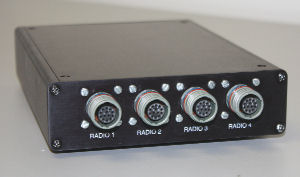A new type of warfare requires a new way for soldiers in the field to communicate with each other and their commanders. At Tactical Communications in Camarillo that new way comes in a thin black box easily installed into a ground vehicle, ship or plane and uses an Internet connection to transmit voice calls and data. Voice over IP is not new for the military but executives with Tactical said their method is different because it allows continued use of existing communications equipment rather than replacing it at a high expense. As far back as 40 years ago, the U.S. military used an early computer network called Arpanet for its communications that would later evolve into the Internet. “This takes the military back to their roots of using an Internet-type technology for communicating,” said Gregory Peacock, the chairman of the board of Tactical Communications. Tactical is a spin-off of circuit board manufacturer Voiceboard Corp. and originally served the telecommunications industry before transitioning to serve the military market. Research and development of the software going into the communications devices is done in Camarillo and North Carolina. A third-party manufacturer in Simi Valley makes the boxes. These boxes replace the first generation of military communication equipment that came with distance limitation, were too big and heavy, and couldn’t operate with other equipment. Analog signals were sent using central office equipment. VoIP popularity Voice over IP, in contrast, sends digital data in packets and removes the limitations of distance, weight and size. VoIP has gained traction in the consumer market through companies like Skype, approaching 50 million daily users toward the end of 2009, and Vonage, with 2.5 million lines in the second quarter of last year. For military use Tactical Communications had to come up with a box capable of withstanding the harsh conditions of a battlefield while tying together telephone, radio and satellite communications. What the company offers is similar to the Warrior Information Network – Tactical being rolled out in phases for the U.S. Army to give mobile communications using broadband and satellites. The company’s offerings are not yet in full production with installations limited to the unmanned aerial vehicle Global Hawk, AWACS surveillance aircraft belonging to NATO, the unmanned Hummingbird helicopter, and the British, Thai and Slovak armies. All the major U.S. defense contractors – including Boeing, Northrop Grumman, Lockheed Martin, and General Dynamics – are aware of Tactical Communications and what it has to offer. These contractors are not developing their own communications systems because they do not have the staff to build a system from the ground up, Peacock said. Instead, these companies assemble parts and components made by smaller firms, he said. Anticipating needs To stay the game it is up to Tactical Communication to stay ahead of the curve and to anticipate the new technology and components the contractors will want, said CEO Carey Walters. “A lot of our R&D is the D – development,” Walters said. “Our customers are bringing us opportunities.” In the six months since joining Tactical, Walters has met with nearly a dozen defense contractors, getting inside the “palace gates” as he put it, to make sure that the company’s equipment means something to the contractors. Peacock, whose background is in telecomm startups, calls himself the technology evangelist who meets with these same customers to provide the answers to the issues they raise. Establishing good relationships with the contractors can lead to getting in on government contracts that can last up to a decade, providing a reliable and stable source of orders. By anticipating what devices and components will be needed, Tactical can have them ready when the orders come in, Walters said. “We are nimble,” Peacock said. “I want to make sure these players understand that.”
